Martin Wows NAMM 2020 with the Ultramodern SC-13E
The first 13-fret Martin model offers ergonomic versatility in a beautiful, cutting edge acoustic-electric guitar
SC-13E specs include: New 13-fret asymmetrical S body size with deep scoop cutaway; fine koa veneer back and sides over solid Khaya core; solid Sitka spruce top; unique asymmetrical Tone Tension X-bracing with partial scalloping; new heel-less Sure Align neck with new asymmetrical ergonomic Velocity profile; solid ebony fingerboard with High Performance Taper; new solid ebony sloped belly bridge with 2-5/32” string spacing; new Road Series Style 13 appointments unique to this model; faux tortoise asymmetrical teardrop pickguard; chrome Grover open back tuners; Fishman MX-T electronics with onboard tuner. Comes with a waterproof, plush-lined gig bag.
An edited version of this original review appears in the January 2021 issue of Martin – The Journal of Acoustic Guitars.
“Not your grandad’s Martin, the SC-13E is an ultramodern acoustic-electric guitar of tremendous versatility and unmatched ergonomic ease. Its advanced shape and cutting-edge technology achieve an effortless playability that is ideal for lengthy practice and performance sessions, while creating a satisfying tonal balance that is good for countless musical styles.”
January 15, 2020 (Revised August, 2020)
At three o’clock today, Pacific Standard Time, C. F. Martin & Co. unveiled to the public the SC-13E, featuring the first new Martin-invented body shape in 86 years. With its advanced asymmetrical S size, deep angular Cutaway, and the attractive updated Style 13 appointments, this revolutionary acoustic-Electric marvel met with unprecedented praise from all quarters of the guitar-playing world.
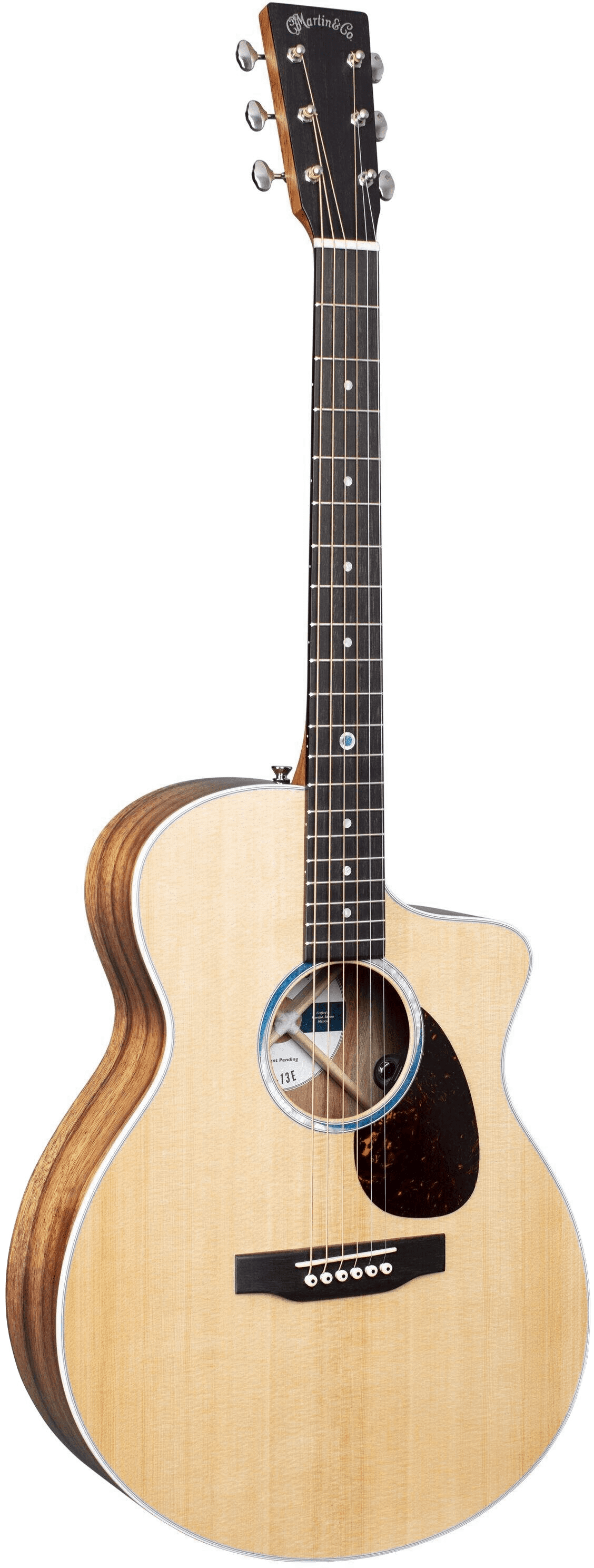 Where other recent models have bodies that were inspired by older designs reaching back to the 1930s, the Martin-invented S body size is the basis for a truly original, ultramodern twenty-first century acoustic guitar. Its incredible new technology eliminates the heel from the fast, shapely neck, making available the entire fretboard while providing exceptional ergonomic comfort.
Where other recent models have bodies that were inspired by older designs reaching back to the 1930s, the Martin-invented S body size is the basis for a truly original, ultramodern twenty-first century acoustic guitar. Its incredible new technology eliminates the heel from the fast, shapely neck, making available the entire fretboard while providing exceptional ergonomic comfort.
Acoustic guitarists will be drawn to the SC-13E because of its balanced unplugged tone and weight distribution. Electric guitarists will adore this model as an acoustic guitar with a cutaway that works seamlessly with all of their complex stage gear, thanks to the plug-and-play Fishman electronics. And both will love how effortless it is to play for extended periods of time.
Martin has introduced this new body size in Style 13, at a price point accessible to any working musician. Its stunning good looks include Celestial blue inlay as part of the top trim, the avant-garde Aperture sound hole rosette, and the matching bullseye position marker at the 12th fret, as well as some seriously gorgeous tonewoods.
The back and sides feature primo Hawaiian koa, laid down as a fine veneer over solid Khaya from West Africa (Khaya ivorensism,) which is nearer to tropical American mahogany in hardness and specific gravity than other African wood. That is why furniture makers have called it African mahogany for centuries, and why luthiers have used it for many years to make acoustic guitars, electric guitars, and classical guitars. This building technique was also used to make the original Road Series Martins and returned on the Style 12 koa models this past year. It allows for great looking wood on the outside, while having a Khaya core for strength and stability.
Photographs can’t do justice to the 3D holographic tapestries of koa grain, woven from hues of pepper-flecked cinnamon, honey, and amber, with glinting rays of golden thread that sparkle from under a crystal-clear, high gloss finish. Breathtaking!
The soundboard is solid, straight-grain, quartersawn Sitka spruce from the Pacific Northwest, prized for its broad dynamic range. Martin has picked out some nice looking tops for the initial run of this new model, with balanced color variation that goes well with all that glorious koa. And the soundboard is nicely flexible and responsive, partly because of the special bracing that was developed for this specific body.
To get the most out of this new sound chamber, the design team renovated the classic X-bracing devised by C. F. Martin Sr. in the 1840s. The result is the innovative Tone Tension bracing, with enhancements that include an X brace scalloped on the treble side for resonance and tapered on the bass side to increase low-frequency response. This explains why the bass E string is never overwhelmed by the other wound strings. They all sound with identical volume and projection. Another guitar may not exist that has such perfect string to string balance. It even has a second X brace to support the back, visible through the sound hole – one of the many Martin firsts on the incomparable SC-13E.
New Martin for the New Decade
Fred Greene, Martin’s Vice President of Product Management, wanted an asymmetrical production model for some time now. The development team explored fresh concepts and back burner experiments that had simmered in the R&D department for years before arriving at the exciting final version released to the general public.
For the first time in Martin model history, the S signifies the actual body shape, rather than it being an initial, as in D for Dreadnought, or J for Jumbo. Tim Teel, Manager of Instrument Design, said the naming was as simple as noticing the S apparent in the fluid curves he kept sketching during early brainstorming. As he put it, “In the end, I feel the S stands for whatever the player decides it stands for, on a personal level. Maybe it will stand for Stage, or Studio, or Stadium, or Solo, or Sexy, or Shredder. It is such a versatile musical instrument; it will earn every one of those designations, and more.”
The S could also stand for Serious, as in the serious versatility that will earn many fans among rock and jazz players who wish to perform on an acoustic guitar without compromising their technique and style. A broader spectrum of guitarists will embrace this model’s comfy contours, which are unique from all other Martin body sizes or anyone else’s body sizes for that matter. It feels right at home in the lap, resting on either knee. And it’s superbly suited for playing standing up, with a strap button installed on the bass-side shoulder, so the hand remains unhindered in the upper frets.
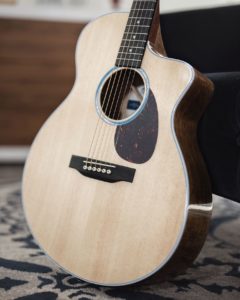 It is fitting that the SC-13E was released in the Style 13, atop the affordable Road Series. This is Martin’s first 13-fret model. Guitars with thirteen frets free from the body existed before and after Martin introduced the first 14-fret six-string guitars in 1930, the fabled Orchestra Models that transformed acoustic guitar design ever afterwards. However, this 13-freter is anything but a throwback to the old days. It is all about playing thoroughly-modern lead guitar.
It is fitting that the SC-13E was released in the Style 13, atop the affordable Road Series. This is Martin’s first 13-fret model. Guitars with thirteen frets free from the body existed before and after Martin introduced the first 14-fret six-string guitars in 1930, the fabled Orchestra Models that transformed acoustic guitar design ever afterwards. However, this 13-freter is anything but a throwback to the old days. It is all about playing thoroughly-modern lead guitar.
Rameen Shayegan, International Design Manager, said that most every aspect of this project was informed by the needs and feedback of a great many guitarists. “One of the first elements we focused on was the position of the neck joint. We split the difference between Martin’s original 12-fret designs and the later 14-fret designs more prevalent today, to make it extra-comfortable for as many guitar players as possible.”
With the shoulder at the 13th fret, the far end of the fingerboard is closer to the guitar’s body, so the 25.4” long-scale neck feels more like a short-scale neck, while retaining the potential energy in long-scale string tension. Having all the frets closer to the guitarist’s body reduces repetitive stress upon their wrist, elbow, and shoulder, so they can convert more of their kinetic energy into free-flowing music for longer periods of time.
The roomy cutaway starts at the 17th fret and slants downward, so all 20 frets are within easy reach. The distance between the highest frets remains unchanged, so the fingers do not encounter the traffic jams found on a short-scale guitar, a persuasive selling point for those who require a cutaway. And by having no heel, chord shapes and note runs can be achieved above the 12th position without contorting the hand or distorting the strings, and the tone along with them.
The 13-fret neck is a major factor in the comfort quotient of what is still a full-size instrument. The total length is 40-1/2” (the same as Size D,) while the body length is 20-3/8” (a smidgen longer than Size M.) At its widest it measures 15-1/2” (closer to Size GP than OM.) The asymmetrical silhouette shifts the bass side toward the neck and the treble side toward the lower bout. This means less of the sound chamber’s cubic volume is eliminated by the cutaway, while making the body seem shorter than it actually is.
Since it has the same comfortable 4-1/8” side depth as the 14-fret 00 and 000 sizes, the SC-13E’s ratio of top width to body depth adheres to the best Martin traditions, even on such a non-traditional Martin guitar. But then then there is that astonishing physical poise. Unlike typical acoustic guitars, the overall weight is centered directly on the neck joint. It hangs from a shoulder strap perfectly balanced between the headstock and the end block. As a result, the potential for full-fledged Elvis dancing and Van Halen fretboard tapping is through the roof.
The basic shape came together rather quickly during the evolution of this new Martin model. It was the details surrounding the bracing and neck that took a lot of experimentation.
A New Neck for the New Martin
The select hardwood neck is attached to the body by the patent-pending Sure Align system, which is a noteworthy departure from previous Martin luthiery. The internal wooden neck block is meticulously sculpted from solid African sipo to accommodate the 4mm two-way adjustable neck rod and the components of Martin’s new Linear Dovetail neck joint, currently exclusive to the SC-13E.
The strings on the SC-13E are set for “ultra-low” by default, compared to the old-timey Martin action I am used to hammering away at. But then even the traditional Martins are sold with lower action than I normally prefer.
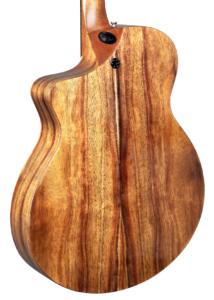 A Martin dealership technician can set the action to the guitar owner’s preferred height in no time at all, by exchanging a prefabricated shim in a narrow slot just beneath the fingerboard. Precise adjustments to the intonation are made via a small Allen wrench inserted into a set screw on the treble side of the truss rod, something that could be done at home by the owner if they are accustom to traditional neck rod adjustments. Although, I should point out, Martin recommends all neck setups be done by a trained professional.
A Martin dealership technician can set the action to the guitar owner’s preferred height in no time at all, by exchanging a prefabricated shim in a narrow slot just beneath the fingerboard. Precise adjustments to the intonation are made via a small Allen wrench inserted into a set screw on the treble side of the truss rod, something that could be done at home by the owner if they are accustom to traditional neck rod adjustments. Although, I should point out, Martin recommends all neck setups be done by a trained professional.
Where the shoulders meet the neck, the conventional obstacle of a heel is replaced by a radical concave scoop, granting unfettered access to the entire fretboard. In other words, it’s like having an electric guitar neck that actually works on an acoustic guitar – a holy grail for many musicians.
To make the most of these technological breakthroughs, the SC-13E comes with Custom Light gauge strings that feature a .11 treble e string, allowing this new Martin acoustic guitar to respond and perform very much like an electric guitar indeed. The default setup provides a relaxed playing experience that is fun and rewarding, with full-step Jimi Hendrix bends and waggling Nita Strauss vibrato.
Light or medium gauge strings can be used by those who prefer the action and dynamics of their traditional acoustic guitars, while still reaping the ergonomic advantages exclusive to the S size and its new neck. That remarkable neck must be experienced to fully grasp its virtues, both the futuristic ones and those rooted in Martin’s venerable heritage. For all its ground-breaking specifications, this unconventional hybrid cutaway acoustic-electric guitar has an important feature found on the best vintage Martins from the pre-war era. The side of the neck held by the thumb is shaped differently than the side manipulated by the fingers.
A New Profile for the New Neck
The neck profile debuting on the SC-13E was inspired by the incredibly comfortable neck on the priceless 1930 OM-45 Deluxe in the Martin Museum. I was in the Custom Shop office the moment they discovered the unexpected secret of that incredibly comfortable vintage neck, back in 2014 when they were designing the Authentic Series replica. Essentially, that vintage V profile is skewed, so the apex drifts off-center, keeping it in the nook of the cupped hand as it advances up the frets. The profile on Martin’s neck of the future has no V. It is carved more like the Low Profile used on the OM John Mayer model; yet it has its own distinctive skewing.
Tim Teel named it the Velocity Profile and described it as “an asymmetrical barrel that twists in a helical manner to move ergonomically with your hand in all playing positions.” From the 1st fret, where the hand is angled outside of the wrist, to higher positions where the hand is in-line with the wrist and turned parallel to the floor, the Velocity Profile remains an absolute joy to hold.
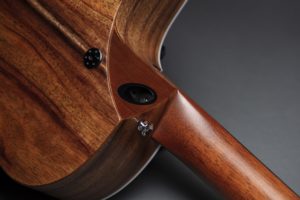 Guitarists encountering the SC-13E in a shop may not even notice the subtle way its neck adjusts to their playing. But that is the point; the neck shouldn’t be noticed. And in this case, the neck is so kind to the fretting hand that the guitar practically plays itself.
Guitarists encountering the SC-13E in a shop may not even notice the subtle way its neck adjusts to their playing. But that is the point; the neck shouldn’t be noticed. And in this case, the neck is so kind to the fretting hand that the guitar practically plays itself.
The solid ebony fingerboard has a depth identical to those on the Authentic Series instruments, while also having the High-Performance Taper of most contemporary Martins. So, it begins with a roomy 1-3/4” width at the nut and measures a slender 2-1/8” across the 12th fret, a scant 3/8” difference that enhances the sleek electric guitar feeling.
Speaking of solid ebony, the sloped belly bridge is another improvement. Both low and smooth, it is free from the usual interior edges that dig into the hand when it’s resting on the bridge or palm-muting the strings.
A New Versatility for New Music
The versatility of this new guitar will overcome anyone’s reservations about it seeming so different from other Martins. In fact, a famous bluegrass phenom was visiting the Martin factory before the SC-13E was released, and absolutely loved playing it.
And playing is what it’s all about – playing for long sessions without the fatigue that can set in with conventional guitars. That is why many people will end up owning this extraordinary Martin model. An even greater number will appreciate its worth as an electrified performance and recording instrument. It simply excels in that capacity.
On stage, the SC-13E will perform any acoustic guitar music straight out of the box. But it also handles anything an electric guitar can do. Run it through distortion, delay, or flange pedals and you just might be amazed at the righteous results. Lay off the gas pedal and settle into a nice groove, and it rings as pretty as any acoustic-electric guitar one could wish for.
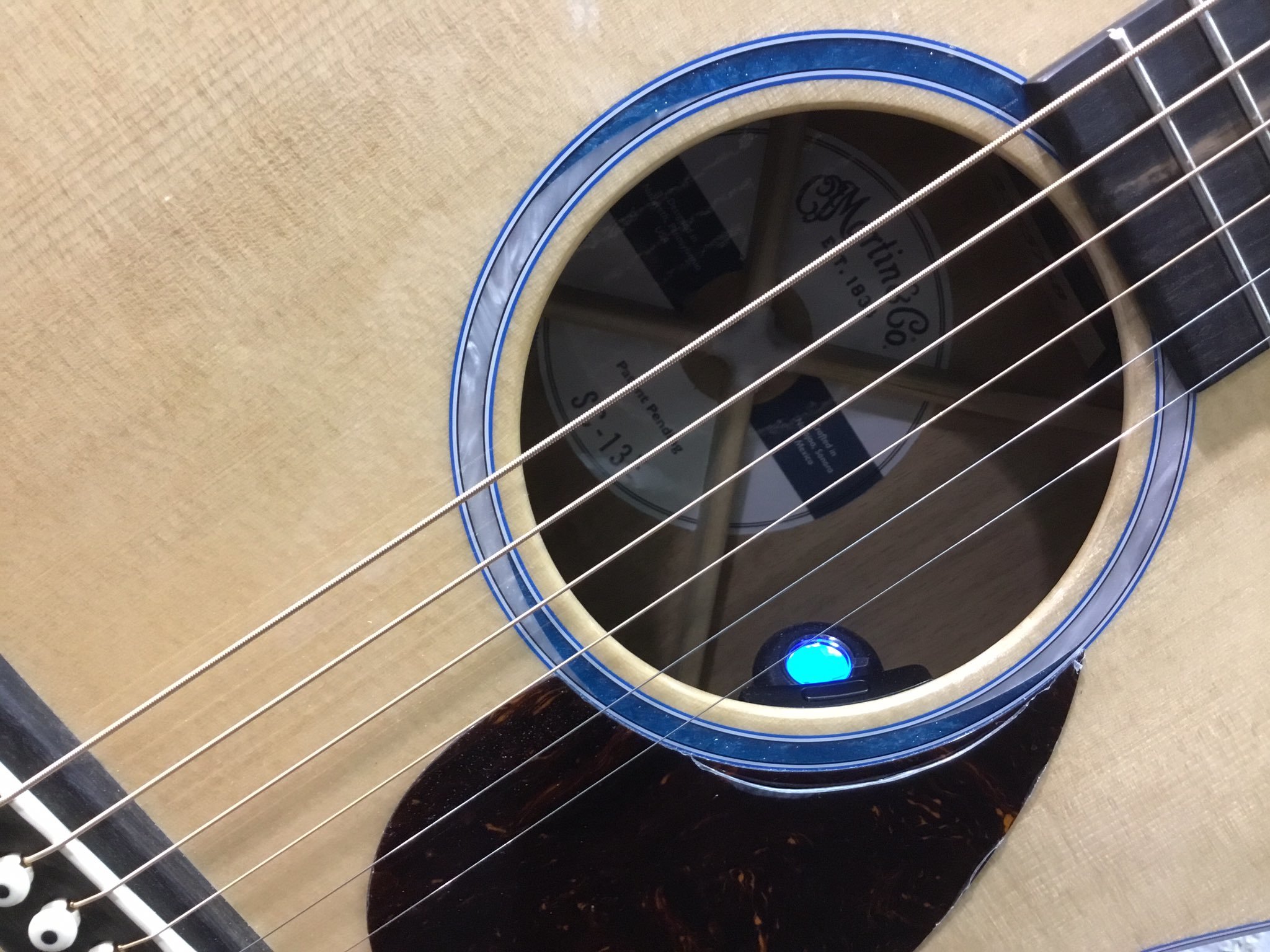 The Fishman MX-T pickup system includes an on-board tuner, discretely hidden inside the sound hole, across from the volume and tone wheel. There is also a switch to cut the bass output in the mix, for those extra-large venues, or when a band doesn’t want the guitar’s bottom end encroaching on the bass and keyboards. When plugged in, the SC-13E can sound downright huge, or lovely and delicate. And that makes for one terrific stage and studio guitar, for not a lot of money. And therein lies the brilliance of Martin introducing this new body size and neck in the Road Series. They are obtainable within modest budgets, while being a relative bargain for those with deeper treasure chests.
The Fishman MX-T pickup system includes an on-board tuner, discretely hidden inside the sound hole, across from the volume and tone wheel. There is also a switch to cut the bass output in the mix, for those extra-large venues, or when a band doesn’t want the guitar’s bottom end encroaching on the bass and keyboards. When plugged in, the SC-13E can sound downright huge, or lovely and delicate. And that makes for one terrific stage and studio guitar, for not a lot of money. And therein lies the brilliance of Martin introducing this new body size and neck in the Road Series. They are obtainable within modest budgets, while being a relative bargain for those with deeper treasure chests.
This elite Road Series model will appeal to younger players shopping in a price range below Martin’s Standard Series. Owners of high-priced acoustic guitars will add an SC-13E to their collection because it is such a distinguished instrument had for such a reasonable price. And avid public performers will love this uncommonly versatile axe that they can bring into clubs and bars, or take on tour in place of their expensive heirloom instruments. And that is exactly what Martin’s Road Series guitars were intended for all along.
The acoustic voice of this guitar is not as robust as traditional Martins. It’s not as meaty in the bottom end, and the unwound trebles do not take to heavy-handed picking as much as I would like. However, I could say as much for any acoustic guitar on the market being offered in the price range of Martin’s Road Series. Any such criticism is made in comparison to high-end Martins from the Authentic, Modern Deluxe, and Standard Series.
To my ear, the tonal spectrum and dynamics are closer to a short-scale 14-fret 00 from the Standard Series than a long-scale OM. How much of that is due to low action and Custom Light strings, how much is due to the new design features, and how much is due to the Road Series construction level, I cannot say. But like other Road Series instruments, once I adjusted my attack to a relaxed and lighter touch, the guitar responded with clear fundamental notes and some quick body reflection not very different from Martins made with solid koa back and sides.
I will break my usual silence about Martin Research and Development topics long enough to say I have played multiple prototypes from the SC project, including those with more-expensive levels of tonewood and trim. The future may hold good things for those who are interested in a guitar with this neck and body shape that will be built with the goal of providing the best unplugged, acoustic tone Martin can offer with the SC body size. And I may be at the front of the line to acquire the first SC sold with Standard Series woods and construction features, should such things come to pass.
My personal custom shop Martin “000C-21 TSP” guitar was also designed with comfort and playability in mind. This is why it has a short-scale neck. But there are times when I wish it has the larger voice and more powerful dynamics of a long-scale guitar. And I would so love the kind of asymmetrical skew to the neck shape on the Modern Deluxe models or that 1930 OM I love so much.
I have been imagining something along the lines of a long-scale mahogany custom with a Sitka top to serve as the TSP’s companion. But now the SC-13E has given me a lot more to consider. The 13-fret design and totally free cutaway, along with the new neck profile, well, it adds up to a very attractive offering to be sure.
Not your grandad’s Martin, the SC-13E is an ultramodern acoustic-electric guitar of tremendous versatility and unmatched ergonomic ease. Its advanced shape and cutting-edge technology achieve an effortless playability that is ideal for lengthy practice and performance sessions, while creating a satisfying tonal balance that is good for countless musical styles. There is little wonder it has created so much buzz and that its popularity grows as guitarists learn firsthand how it lives up to its reputation.
I am very pleased with how this project turned out. And I am sure my Django Reinhardt-Fats Waller-Irving Berlin-Duke Ellington-Chuck Berry-Merle Travis-Bob Dylan-Beatles-Stones-Dead-Neil Young-John Prine-David Bowie-Elvis Costello-Leo Kottke-R.E.M-Joan Armatrading-Tom Waits-Townes Van Zandt-Laurence Juber playing self would be very happy to keep on fingerpicking and flatpicking an acoustic-electric guitar as ergonomically comfortable and musically versatile as this new Martin SC-13E. I can only imagine how the acoustic/electric hybrid emulators of John Mayer, Keith Urban, Jason Isbell, Alex G., and Courtney Barnett will love this Swiss army knife of a new Martin.
And that is one man’s word on…
The Martin SC-13E
List Price: $1,899.00
Call your Martin dealer to find out their best price!
More Photos Here
Additional Reading
Martin SC-13E Special and SC-10E Revealed!
Note: FYI We didn’t have much time. I just plugged in and said, “That’s sounds ok. Let’s try it.” We thought the audio was ruined by electrical interference, but it actually recorded OK. So you can hear how ‘acoustic’ the plugged-in tone of this guitar is through a Fishman Loudbox Artist amplifier.
courtesy of maurysmusic.com
Martin on Martin
Jason Ahner of Martin Guitars and your humble Spoon discuss this new Martin.
Official SC-13E Spec Sheet Here
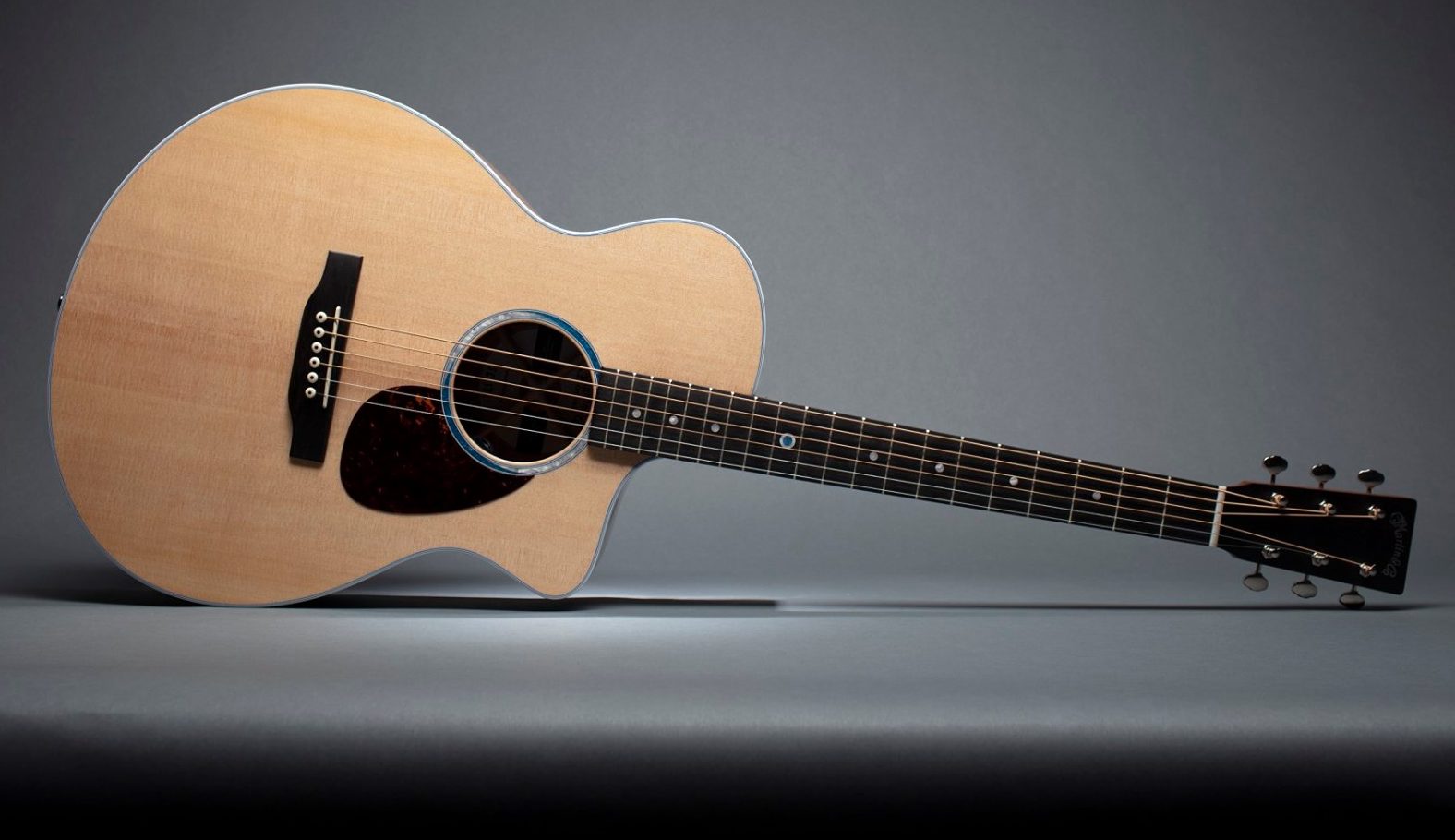
Brought one home today. Great tones, resonance, & responsive playability. the S also can stands for “silky-smooth
This is a great review! Thank you. So the SC-13e is in fact solid wood back and sides, right, African Mahogany? The Koa (or ziricote) is just put over the solid wood African Mahoney. Is that right? Thank you so much.
Thank Bill. Martin does not call it “solid tonewood” because of the veneer on the front and back of each plate of wood. The core is solid African mahogany, not plywood. But that core is a bit thinner than would be a typical solid piece of back or sides.
Looking forward to playing one of these when they arrive at my local Martin distributor.